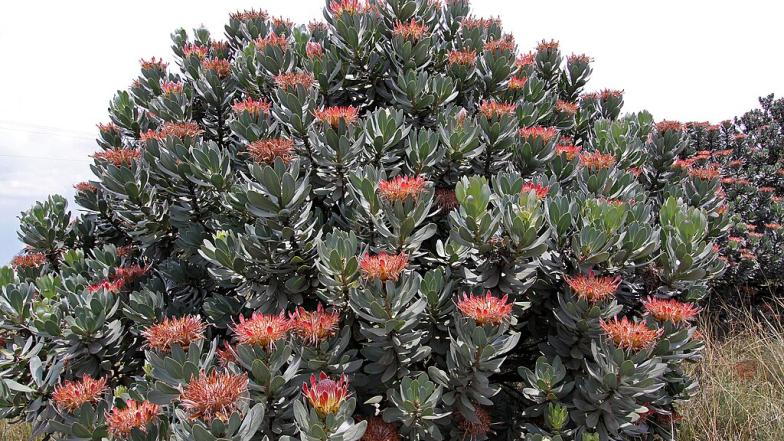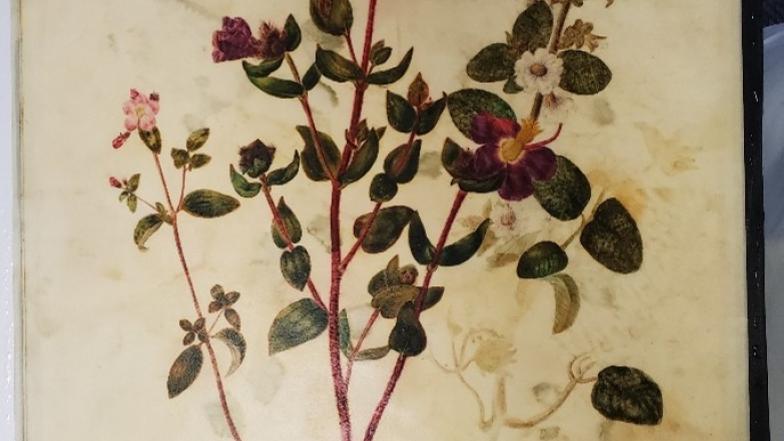Spring Time for Special Collections

This spring season, UCTL Special Collections is celebrating springtime with a feature on the successful salvage and recovery of thirteen renowned botanical water colour paintings by Arabella Roupell.

Attribution: SAplants, CC BY-SA 4.0, via Wikimedia Commons
A word on the artist
Arabella Roupell (1817-1914) was the wife of Thomas Boone Roupell of the East India Company. His work led the couple to be stationed at the Cape of Good Hope between 1843 and 1845, where Arabella observed and painted the local flora with great beauty and scientific precision. Roupell was prolific, also painting Asian flora during her extended stay in India. In 1849, she anonymously published Cape flowers by a Lady. While UCT Libraries does not hold custody of all her work, the botanical drawings featured in the 1849 book are held by Special Collections.
The long journey to UCT
Arabella’s paintings have travelled an exceptionally long journey since their creation nearly two centuries ago – including survival of the Jagger Library fire. The original paintings were left to her grandson, George Roupell. In the 1930s, after engaging with Mary Gunn, then-librarian at the Botanical Research Institute in Pretoria, and learning that General J.C. Smuts had taken an interest in these water colours, George Roupell gifted them to him.
Through the Smuts family the paintings were passed to Gunn for examination and she identified them as the long sought-after collection. The Smuts family donated the collection to UCT which placed them in the library of its botanical research unit, the Bolus Herbarium. Kept in the Bolus Library for many years, they were eventually deposited in the Libraries' Manuscripts and Archives as part of the extensive Bolus Papers (BC234).
This collection is a source of great pride to Special Collections, and their survival of the Jagger fire has been widely celebrated, notwithstanding limited water damage to 13 of these hand painted drawings which were described in 1850 in the Hooker's Journal of Botany and Kew Garden Miscellany as “made on the spot by a lady of high talent and accomplishment in the art of drawing and colouring.” The related footnote highlighted how much interest was garnered by the publication of these drawings.
“The name is modestly withheld throughout the whole of the work, but on the authority of the ‘Botanical Magazine’, under Roupellia grata (vol. lxxiv. tab. 4466) we are enabled to say that these admirable drawings are the work of the Lady of Thomas Boone Roupell, Esq., a gentleman now high in the Civil Service of the East India Company.”
Her illustrated specimen of Roupellia grata (pictured below) was in fact the only non-South African plant included in the illustrated publication, providing an important clue for those keen to name the artist. The illustrations of flora, described recently by Sotheby’s as ‘exuberant’, both emulate the natural beauty of their subjects and the scientific rigour of their admirers. The University of Cape Town has displayed the collection numerous times, including a 2002 display at the Irma Stern Museum, and almost regularly in the Jagger Reading Room once Manuscripts and Archives Department moved there.

The salvage and recovery of thirteen Roupell Cape flora water colours
By 2015, the collection of original artworks had been rehoused in bespoke enclosures. They were preserved in the first basement of the Jagger Library and they were kept immediately below the Reading Room. Flooding in this area did not spare the drawings, with one stack of thirteen mounted paintings entirely saturated with water. They had to be carefully extricated on a specially made field stretcher for documents to prevent further damage. The items were treated with great care, prioritised in the Triage Tent, almost immediately treated, and placed in cold storage.
In 2023, they were among the first items to undergo the complete process of restored in the new Conservation Unit. The thirteen impacted watercolour paintings presented varying degrees of damage, with each piece requiring a unique treatment approach tailored to its specific condition. The damages included water stains, tears, losses, mould growth, and media bleeding. Conservation treatments ranged from carefully washing the paper, freeze drying to stabilize and delicate tear repairs to restore structural integrity. Each painting was handled individually, with conservation strategies selected based on the extent and nature of the damage to preserve the integrity of the artwork.
One particularly compelling case, pictured below (with reference BC234_BOT_A17), suffered extensive damage from water exposure, resulting in severe warping, creasing, and bleeding of the media. The widespread discoloration and staining were further complicated by the presence of mould. This painting, salvaged from the Jagger Library, had stuck to its support mount, making it challenging to document its condition before treatment.

Initially, the painting was placed in a fume hood for surface cleaning with a 70% ethanol solution, which effectively removed fungal colonies. However, when subjected to freeze drying, rapid drying caused minor damage due to the delicate nature of the paper, leading to a halt in the process. Consequently, a decision was made to employ a shallow water bath to reduce staining, following thorough spot tests to avoid additional bleeding. During this process, the painting separated into three layers, each of which was individually cleaned due to mould present between the layers. After rinsing and carefully drying the layers between blotters, they were re-adhered using wheat starch paste and aligned to their original positions. Despite the significant reduction in staining, some discoloration persisted, highlighting the complexity and care involved in conserving such delicate artworks.

This case underscores a critical insight in conservation: even though two objects might appear similar in materiality, their treatment can vary significantly based on how each respond to conservation methods. In this instance, the watercolour painting's unique reaction to freeze drying, and its separation into layers during bath treatment, demonstrated that each object’s individual characteristics and condition dictate the specific approach required. This highlights the importance of adapting treatment strategies to the unique needs of each piece, ensuring that conservation methods are tailored to the material’s response and preserving the integrity of the artwork.